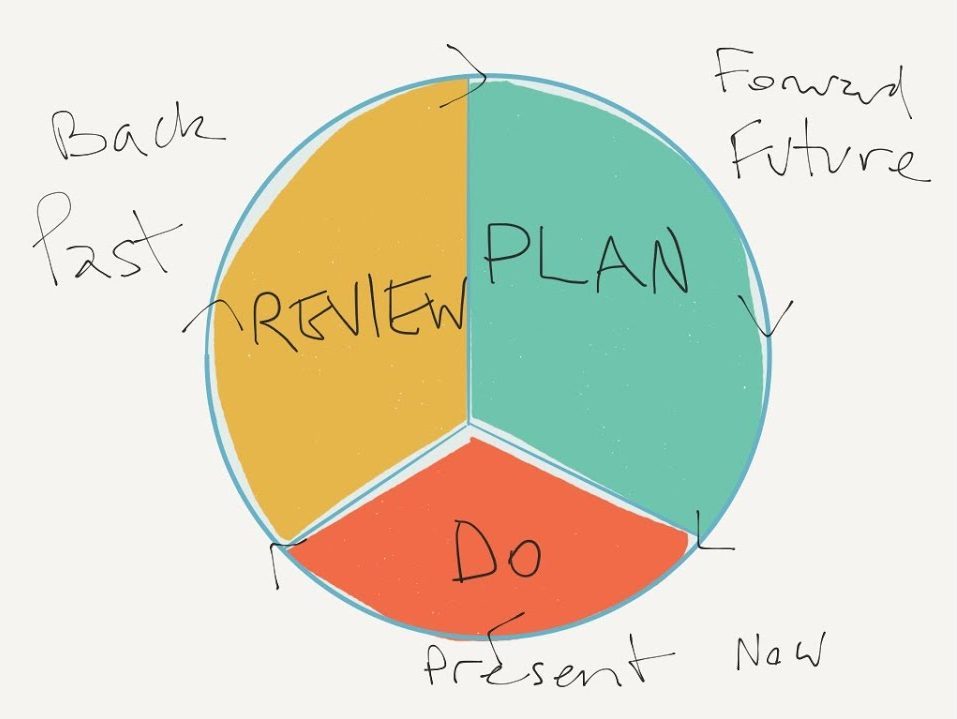
For most of us, life is busy and constant most of the time. I like to be organised, and with 3 young kids I need to be organised. I’m pretty good at it sometimes but things still slip through; or I get waylaid by other things I think I should be doing (that I don’t actually need to do). Pretty soon, goals fade and I live from day to day in survival mode.
Today we have so many tools at our disposal to help us stay organised and focused on our tasks and goals.
Some people love to use simple, tried & true, pen and paper: physical worksheets, journal, diary, notepads, lists, wall calendar, the back of receipts and napkins…
Some people love the latest gadgets and apps: task & project management apps, habit tracking, goal tracking, mood tracking, spreadsheets, online mind-mapping apps, online calendars with many overlaying calendars with colour-coded events.
Some tools help but tools can become a distraction or we do not use them well or consistently to reap their benefits. So we toss them away and we write off the potential value they can bring. Or we blame the system instead of the user.
I figured, for me, it’s a user issue…
These tools, whether tangible products or virtual applications, can draw us closer to victory, or frustration or even apathy.
After a busy and unfulfilling year, I wanted to dig deep and identify out my new challenges, where things became stagnant and where I needed to grow. With some new year soul-searching and reflection, I did a quai-SWOT analysis on my career and personal life.
I had lost energy and motivation, no margin and was not enjoying things that normally brought me joy. I was not nurturing good habits, too busy with things I didn’t want to be doing, and perhaps shouldn’t be doing. I didn’t want a repeat of last year. Instead, I wanted joy, margin, focus and freedom.
After this typical annual review and big picture planning, I analysed the routines that were missing and that assisted things to fall off the metaphorical tracks.
PROBLEM 1: I did not have a method to visualise my goals easily
Trello, my faithful task and online list app was full. The big bucket of thoughts and actions and goals was not designed to contain my whole brain in that format.
PROBLEM 2: I was good at reviewing the year but not month, week or day
Celebrating and reviewing a year is a natural thing to do when we approach new year, but we do not typically celebrate months, weeks or days. I had a calendar event for another job to do a weekly review, but was never disciplined at sticking to it.
PROBLEM 3: I would rarely plan out my day, week or month
The tyranny of the urgent over the important. I often felt like I was putting out fires or making things up as I went. I would turn on my computer, check email then expect things to just happen. Some days were productive, other days felt wasted.
PROBLEM 4: I felt like I had no margin, no ‘me-time’
The feeling of being busy is ok for a season but cannot be sustained. I did not think I had a choice in how I spent my time, which spun into a cycle of decreased energy and motivation and then not spending time on things that I enjoyed and life-giving activities.
PROBLEM 5: I felt bound and obligated to do things and see people, even if I didn’t want to
This is a tricky one. You receive an invitation to something. You have a conversation with someone who wants more of your time. You see something that needs doing and no one else is running to do it… It’s easy to feel bound to put in, do that thing, see that person. And there are times that you need to say yes. It really is a case-by-case basis. But feeling that there is no margin, where do you draw the boundary line and what are the criteria for saying yes and no? Again, it is a tricky one.
So basically, I sucked at planning and reviewing and needed an easy way to visualise my mind and goals.

Plan and Review were the missing stages of my life
1) Visualise your mind & goals
First thing, draw a mind-map of my mind and goals; every aspect of your job, career, family and personal life, then break down into sub-items and goals, using a free mind-mapping tool called Coggle. This is a very cathartic and freeing exercise.
Seeing my mind at a glance means I don’t continually do mental acrobatics across tasks, goals and areas of life. This is the mental equivalent of having one application or task to focus on instead of multitasking and the CPU running at 100%. This saves so much energy and gives a keener purpose and focus to every task.
You also need a way to see this on a regular basis. It is no good having goals written down once and not being able to see them regularly. You need a visual dashboard for this and other areas of planning and reviewing. This could be physical or online, wherever it is that is easy to access and easy to visualise. I am now in the process of building an online life dashboard to display this and other go- to information at a glance.
2) Review regularly
The rhythms of life are really important to understand. For work and personal life, break up your day, week month, and year. Schedule in time to look back and review for each of these levels. It doesn’t need to take too long. But this will be the bridge to connecting your goals and what you do. It helps you to see the progress made, the wins to celebrate, the challenges ahead and what needs to change. Tweak and repeat.
For a daily work review, I setup an online Google Form that saves into Google Sheets and is integrated in my life dashboard, that I write a 1 liner of what I have achieved, a productivity and satisfaction rating.
For a daily personal review, I use a mood tracking app called Daylio. It takes me 20 seconds at the end of each day to rate my mood and what I achieved. Easily customisable and great to see my week/month/year at a glance, see what impacts my good days and harder days.

The other beauty of the review process is that it helps you to become a better you. In a sober and humbling light, it helps to highlight what needs to change and can provide the inspiration to do things differently and better… hopefully both.
3) Plan regularly
In the same vein as reviewing regularly, planning takes dedication and consistency but the fruits of your planning pay you sweetly back. Schedule time to plan and review for each day, week, month and year. Sounds excessive? It doesn’t need to be.
Five minutes at the start of each day, focusing on your most important goals and then generating the next action step (or three) will give you purpose for each day.
Thirty minutes working on a weekly plan to schedule your weekly blocks (see #4), as well as looking ahead in your calendar and consulting other sources such as your local weather will help you optimize your week.
Taking two or three hours to reflect and review the past month and plan your next month of goals and milestones should be a rewarding activity. Go for a walk to take stock, get your Vitamin D fix and some good old-fashioned fresh air then treat yourself at your favourite cafe with pen and paper in hand.
Spend time at the end of the year gathering your thoughts about the year that has been; the highlights and lowlights, personally & in your career. Ask yourself:
- What did you enjoy, achieve and discover?
- What brought you pain and what did you learn about yourself?
- What will you continue to do and what will you change?
- What steps will you put in place to set new habits and goals?
- Who will help you follow up on them?
Planning well brings a laser focus and intentionality to everything you do. There is a reason for each action you take and you know WHY you are doing what you do. The time you spend planning should be saving you more time because you know what to do, how to do it and you will have the reasons you need to not procrastinate.
4) Design your weekly schedule (including margin)
Structuring your typical week schedule into blocks is a great visual tool. Your blocks can be as detailed as every 30 minutes, every hour or two, or even simply ‘morning, afternoon, evening’. I found it most useful to divide my day into two hour blocks starting from 7am through to 11pm. Two hour blocks were long enough to focus on one medium-sized task each. e.g. On an eight hour work day, I can plan (using daily or weekly plan time) to schedule four reasonable tasks from one goal or up to four different goals.
The weekly block helps you feel the flow of each day and week and label what the major focus is for each day (e.g. work, family, me). This discipline helps you to realise your opportunities and limitations.
Utilise the times of day you are most productive for the tasks that require most concentration and focus.
Make sure you schedule ‘me time’ for creating margin. Each week, you get to decide what you do with this time for leisure, personal growth and other life-giving activities. When I finished blocking my week, I discovered I actually had eight x 2 hour blocks of ‘me time’. This pleasant realisation helped me to see that in my busy schedule, I can actually have time to relax and I have no excuse not to look after myself.
Once you have completed blocking, colour code each kind of activity (e.g. Job 1 = red, Job 2 = purple, Family = green, Me = blue). The schedule becomes highly visual and you can see at a glance the flow of the week and how many blocks for each kind of activity. (Double points if you map the block colours to that of your calendars!)
Thanks to the gurus at Productive Flourishing with their guidance on time blocking and the weekly block scheduler.
5) Say ‘No’ to ‘should‘
This is less about process and more about behaviour. If you are a natural people-pleaser (like me) and like avoiding conflict at any cost, then this is the raging battle with yourself; things you feel you should do, events you should go to, people you should see. They might not be bad things to do, but time is short, a finite commodity. Our goals and schedule demonstrate how limited and precious your time is.
If you naturally put your hand up and always say ‘Yes’, stop believing you are the only one who can do a particular task. Ask yourself,
Does this thing help me step closer toward my goals?
Does it fit in the routine of my week?
Does it still allow me to have the margin I need for myself?
FOMO (Fear Of Missing Out) is real but you can break it by accepting the limitations of time and energy. You cannot be everywhere all the time. You cannot get to every event. You cannot see everyone anytime you want. You can learn to be OK with doing less and saying ‘No’.
Stop worrying about being seen, making an appearance and worrying about what other people might think. Identify the people that help build you and grow you, love you and support you, then you have no need to worry about anyone else.
Watch the video for all the gory details, warts and all!



